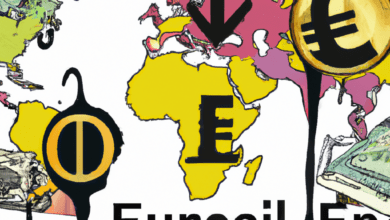Currency Dynamics: Navigating Interest Rates, Geopolitical Events, and Trading Strategies in the Forex Market

In the fast-paced world of foreign exchange (forex) trading, understanding the myriad factors that influence currency values is crucial for both seasoned traders and newcomers alike. This article delves into the intricate relationship between interest rates and currency exchange rates, highlighting how fluctuations can have far-reaching effects on global markets. Additionally, we will explore the impact of geopolitical events, which can cause sudden shifts in forex dynamics, and the role of central banks in shaping currency values through their monetary policies. The discussion will extend to practical trading strategies for major currency pairs like EUR/USD and GBP/USD, emphasizing how traders can leverage economic indicators and inflation trends to optimize their approaches. Furthermore, we will examine the phenomenon of carry trading and its potential for profit through interest rate differentials, alongside the rise of digital currencies and their implications for traditional forex markets. By analyzing these critical aspects, this article aims to provide a comprehensive framework for understanding the complexities of forex trading in today's interconnected economy.
- 1. "Interest Rates and Currency Value: Understanding the Connection"
- 2. "Geopolitical Influence: How Global Events Shape Forex Markets"
- 3. "Trading Strategies in Action: Navigating Major Currency Pairs and Economic Indicators"
1. "Interest Rates and Currency Value: Understanding the Connection"
Interest rates play a crucial role in determining the value of a currency, as they directly influence investor behavior and economic stability. When a country's central bank raises interest rates, it typically results in higher returns on investments denominated in that currency. This attracts foreign capital, leading to an increase in demand for the currency and subsequently driving up its value. Conversely, when interest rates are lowered, the potential returns diminish, which can deter investment and lead to a depreciation of the currency.
The connection between interest rates and currency value is also influenced by market perceptions and expectations. If investors anticipate that a central bank will increase rates in the future, they may begin buying the currency in advance, causing its value to rise even before the actual rate change occurs. This phenomenon can create volatility in the forex market as traders react to economic data releases and central bank communications.
Moreover, the relationship between interest rates and inflation cannot be overlooked. Typically, higher interest rates are employed to combat inflation, and a stable inflation rate often supports a stronger currency. If a central bank is successful in maintaining low inflation, it can foster a favorable environment for currency appreciation as purchasing power remains intact.
In summary, understanding the connection between interest rates and currency value is essential for forex traders. Monitoring central bank policies, economic indicators, and overall market sentiment can provide valuable insights into potential currency movements, allowing traders to develop informed strategies in the dynamic forex landscape.
2. "Geopolitical Influence: How Global Events Shape Forex Markets"
Geopolitical events play a crucial role in shaping forex markets, as they can create uncertainty or stability that significantly impacts currency values. Events such as elections, conflicts, trade negotiations, and diplomatic relations can lead to fluctuations in investor confidence and market sentiment, directly affecting currency exchange rates.
For instance, political instability in a country often results in a depreciation of its currency. Investors tend to seek safer assets during times of uncertainty, leading to capital flight from the affected country. Conversely, positive geopolitical developments, such as trade agreements or peaceful resolutions to conflicts, can strengthen a nation’s currency as investor confidence returns and capital inflows increase.
Moreover, geopolitical tensions can lead to fluctuations in commodity prices, which in turn affect currencies of commodity-exporting nations. For example, rising tensions in the Middle East can drive up oil prices, benefiting oil-exporting countries like Canada and Russia, leading to appreciation of their currencies against others.
Central banks also respond to geopolitical events, adjusting monetary policy to stabilize their currencies. For instance, if a geopolitical crisis threatens economic growth, a central bank may lower interest rates to stimulate the economy, which can further influence currency values.
In the interconnected global economy, the repercussions of geopolitical events are not confined to the nations directly involved. Market reactions can be swift, with currency pairs reacting to news from around the world. Traders and investors closely monitor geopolitical developments, employing strategies to mitigate risks or capitalize on potential opportunities that arise from these shifting dynamics. Understanding the complex interplay between geopolitics and forex markets is essential for making informed trading decisions.
3. "Trading Strategies in Action: Navigating Major Currency Pairs and Economic Indicators"
In the dynamic landscape of forex trading, navigating major currency pairs such as EUR/USD and GBP/USD requires a keen understanding of both market mechanics and the economic indicators that drive currency movements. Traders often employ a variety of strategies tailored to leverage these influences effectively.
One popular strategy is the use of fundamental analysis, where traders analyze economic indicators such as GDP growth rates, employment figures, and inflation data to gauge the health of an economy and make informed trading decisions. For instance, if the Eurozone reports stronger-than-expected GDP growth while the UK experiences a downturn, traders might anticipate a rise in the EUR/USD pair, prompting them to take long positions on the euro.
Technical analysis also plays a crucial role in trading strategies. Traders often use chart patterns, trend lines, and various indicators (such as moving averages and the Relative Strength Index) to identify potential entry and exit points. For example, a trader might spot a bullish trend in the GBP/USD pair after observing a series of higher highs and higher lows, leading them to enter a long position in anticipation of further gains.
Additionally, news trading strategies are prevalent in the forex market. Traders monitor economic calendars for key announcements and adjust their positions accordingly. For instance, if the U.S. Federal Reserve releases a statement indicating a possible interest rate hike, it could lead to a surge in the USD, prompting traders to buy or sell positions in pairs like USD/JPY or AUD/USD based on their analysis of the market's reaction.
Ultimately, successful navigation of major currency pairs is a blend of understanding economic indicators, employing technical analysis, and being responsive to geopolitical events and market sentiment. By integrating these elements into their trading strategies, forex traders can better position themselves to capitalize on the fluctuations inherent in the currency markets.
In conclusion, the intricate relationship between interest rates, geopolitical events, and currency exchange rates underscores the complexity of the forex market. Understanding how interest rates influence currency values is crucial for traders looking to optimize their strategies. Additionally, geopolitical developments can create volatility, impacting trading decisions and market sentiment. As we explored, effective trading strategies for major currency pairs like EUR/USD and GBP/USD hinge on a thorough analysis of economic indicators and the actions of central banks, which play a pivotal role in shaping currency values.
The dynamics of inflation further complicate forex trading strategies, as rising prices can lead to shifts in interest rates and, consequently, currency valuations. Moreover, the concept of carry trading offers opportunities to profit from interest rate differentials, yet it requires a keen awareness of market conditions and risks. As digital currencies continue to rise, their influence on traditional forex markets is becoming increasingly significant, prompting traders to adapt and evolve their approaches.
Ultimately, success in forex trading demands a comprehensive understanding of these interconnected factors. By leveraging insights from interest rates, geopolitical events, inflation trends, and economic indicators, traders can better navigate the complexities of the forex landscape and position themselves to capitalize on emerging opportunities.





